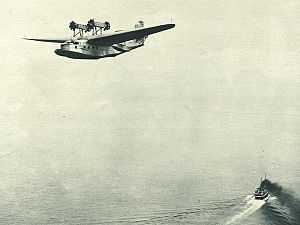Lioré et Olivier LeO H-242
| LeO H.242 |
|---|
 |
| Role |
Passenger flying boat |
| National origin |
France |
| Manufacturer |
Lioré et Olivier |
| First flight |
1929 |
| Introduction |
1933 |
| Retired |
1942 |
| Primary user |
Air France |
| Number built |
15 |
|
|
The Lioré et Olivier LeO H.242 was a French-manufactured flying boat that was used for European passenger air services in the 1930s. Several were operated by Air France.
One LeO H.242 features at the end of Hergé's The Adventures of Tintin comic King Ottokar's Sceptre.
[1]
Variants
- H-24.01
- First prototype. Powered by two 373 kW (500 hp) Renault 12Jb engines. One built.
- H-242
- Initial production. Powered by four Gnome-Rhône 7Kd Titan Major radial engines. Two were built for Air France and delivered in December 1933 and February 1934. They could carry ten passengers. [2]
- H-242/1
- Revised production version. Modified engine installation. Twelve were built for Air France and delivered between March 1935 and May 1937. They could carry twelve passengers.
Operators
 France
France
.svg.png) Italy
Italy
Specifications (H-242/1)
Data from The Encyclopedia of World Aircraft [3]
General characteristics
- Crew: 4
- Capacity: 12 passengers
- Length: 18.45 m (60 ft 6½ in)
- Wingspan: 28.00 m (91 ft 10¼ in)
- Height: 6.33 m (20 ft 9¼ in)
- Wing area: 116.3 m² (1,251 ft²)
- Empty weight: 5,868 kg (12,937 lb)
- Max. takeoff weight: 8,700 kg (19,180 lb)
- Powerplant: 4 × Gnome-Rhône 7Kd Titan Major 7-cylinder radial engine, 261 kW (350 hp) each
Performance
See also
References
- Donald, David (editor).The Encyclopedia of World Aircraft. Leicester, UK:Blitz, 1997. ISBN 1-85605-375-X.
|
|---|
| | General | |
|---|
| | Military | |
|---|
| | Accidents / incidents | |
|---|
| | Records | |
|---|
| | Misc. | |
|---|
|
